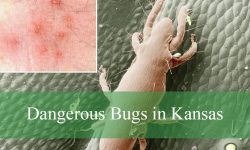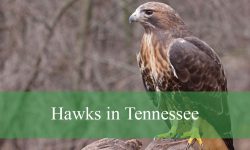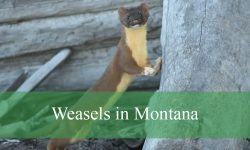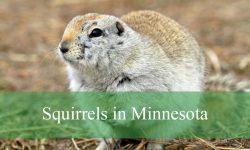Snakes in Montana are an integral part of the state’s rich and varied ecosystems. These reptiles are found in a range of environments, from the expansive prairies and rolling grasslands to the dense forests and rocky highlands. The diverse species of snakes in Montana, such as the vibrant Bullsnake and the elusive Smooth Greensnake, exhibit a range of fascinating adaptations that help them thrive in their specific habitats.
Let’s explore 15 types of snakes in Montana, delving into their characteristics, behaviors, and how to identify them in this article.
Different Types of Snakes in Montana
Valley Garter Snake
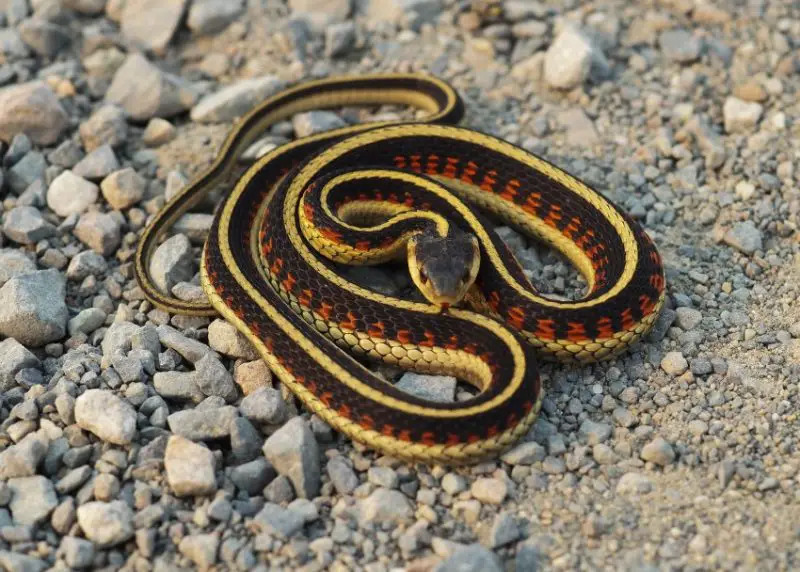
Thamnophis sirtalis fitchi, commonly known as the valley garter snake, has an adult length that varies from 18 to 55 inches. Usually, they have three yellow stripes—one on each side and one down the back—and are brown to black in color. They have a yellowish belly, mouth, and chin, and their black heads frequently have red sides. Notable red bars can be seen in between the yellow stripes.
This subspecies of the common garter snake can be found in a range of habitats, such as fields, wetlands, woodlands, scrublands, shorelines, and rocky places. They also fit very nicely with urban environments. Look for them under logs, boulders, and other cover that helps with thermoregulation in western Montana. They communally hibernate in ant mounds, rock crevices, animal and crayfish burrows, and artificial places below the frost line throughout the winter.
Valley Garter Snakes are good swimmers and will try to go into the water if they feel threatened. If apprehended, they might spit and exude musk, and if they feel very threatened, they might even attack. They are often killed on roads and out of fear, even though they are thought to be low-risk species and have adapted well to human-modified habitats.
Western Milksnake
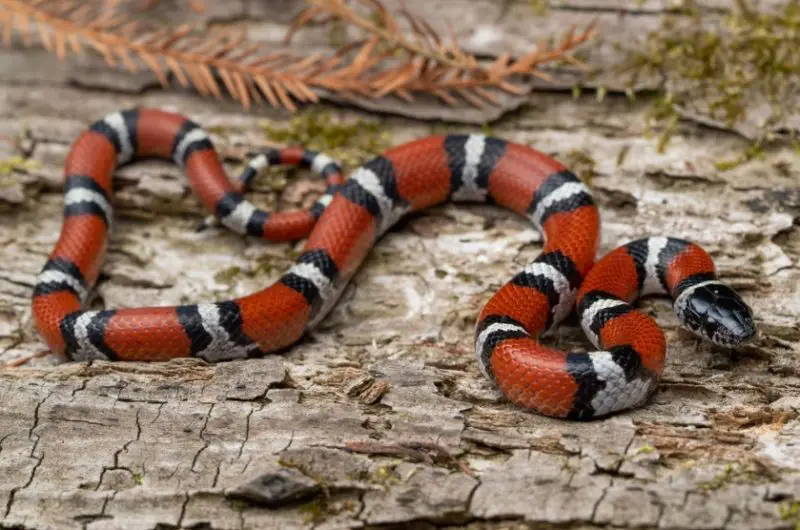
The normal length of an adult Western Milksnake (Lampropeltis gentilis) is between 15 and 34 inches. Their coloration is stunning, with bands of whitish, black, and reddish or orange, the latter surrounded by black. The underside may have band extensions or be more whitish, whereas the snout is typically blackish with probable white flecking.
Western Milksnakes can be found in grasslands, open sagebrush, and occasionally residential areas in eastern Montana. Being reticent, they frequently conceal themselves beneath rocks, logs, boards, and other detritus.
Their coloring can lead to confusion with poisonous coral snakes. The proverb “If red touches yellow, you’re a dead fellow; if red touches black, you’re all right, Jack” can help you tell them apart.
Small mammals, birds, bird eggs, other snakes, lizards, reptile eggs, and occasionally worms and insects are among the many prey items that these snakes consume. They aggressively seek prey, constricting it with their coils. Even though they are generally calm when handled, when they feel threatened, they may act defensively by hitting or vibrating their tails.
Smooth Greensnake
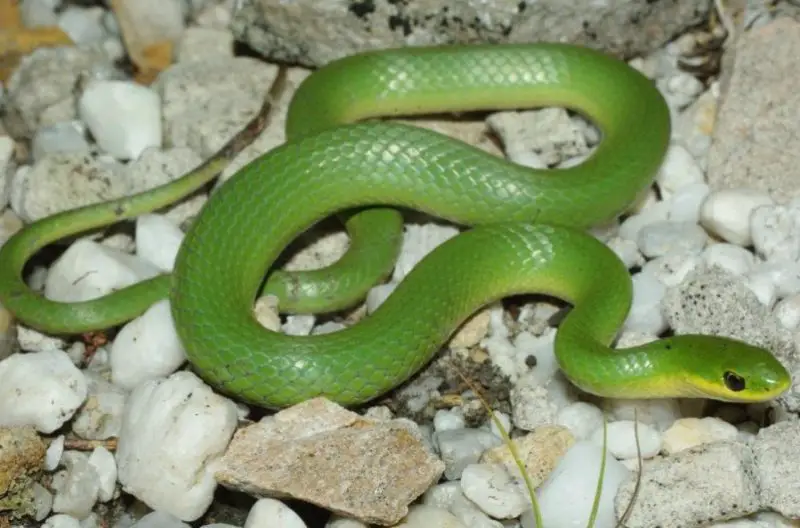
The Smooth Greensnake (Opheodrys vernalis) has slender adults that are usually between 14 and 20 inches long. They have a red tongue with a black tip, and they are all the same light green color with a yellow or white underbelly. Up to their first molt, juveniles might have an olive-green, blue-gray, or brown appearance.
They live in open forests, savannas, meadows, pastures, marshes, and the margins of streams and lakes. They are also referred to as grass snakes, because they favor damp places close to perennial water sources.
Smooth Greensnakes nearly exclusively eat insects and spiders, and instead of suffocating their food, they use fast strikes to subdue and swallow them alive. They hibernate in abandoned anthills and old animal burrows in eastern Montana throughout the winter, frequently in communal settings with other tiny snakes. They appear in the spring, usually in April, and stay busy through October.
These snakes can quickly escape when challenged because of their agility and exceptional camouflage, which help them avoid predators.
Bullsnake
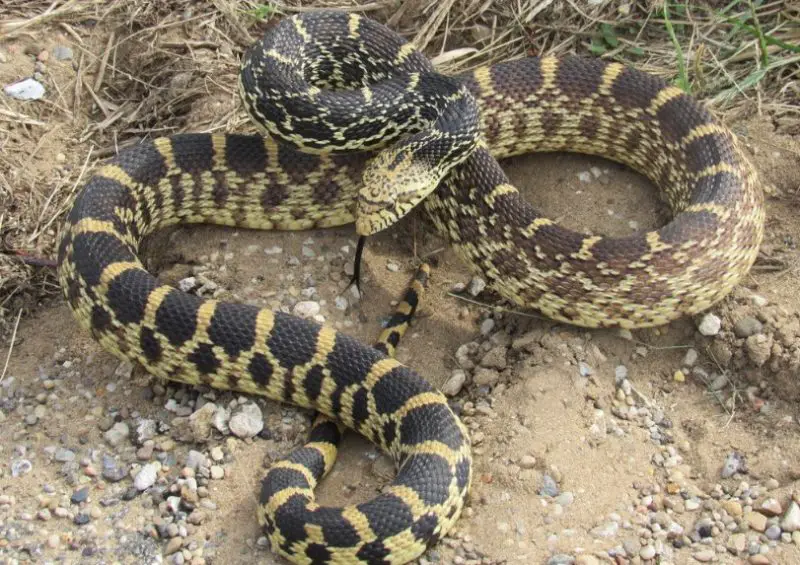
Pituophis catenifer sayi, or bullsnake adults, are huge, usually reaching lengths of 4 to 6 feet. They are yellow, beige, or light brown in color, with three pairs of smaller spots on the sides and a huge brown, black, or reddish splotch on their back. The blotches near the tail may resemble bands, and the underside is speckled with black and golden in color.
In Montana, bullsnakes are typically found in fields, grasslands, forest borders, savannas, brushlands with sandy soils, and regions with high rodent populations, such as prairie dog towns. With their prominent rostral (nose scale) for digging, they can aggressively chase prey in loose dirt due to their speed. They seize their victim and stifle it with their powerful bodies.
Bullsnakes are not poisonous, but they react aggressively to danger. They frequently hiss, raise their front half of their bodies, and lunge at assailants. Because of an expansion of the windpipe and a cartilage flap known as an epiglottis that produces a rattling noise, their hissing can resemble that of a rattlesnake.
Plains Hog-nosed Snake
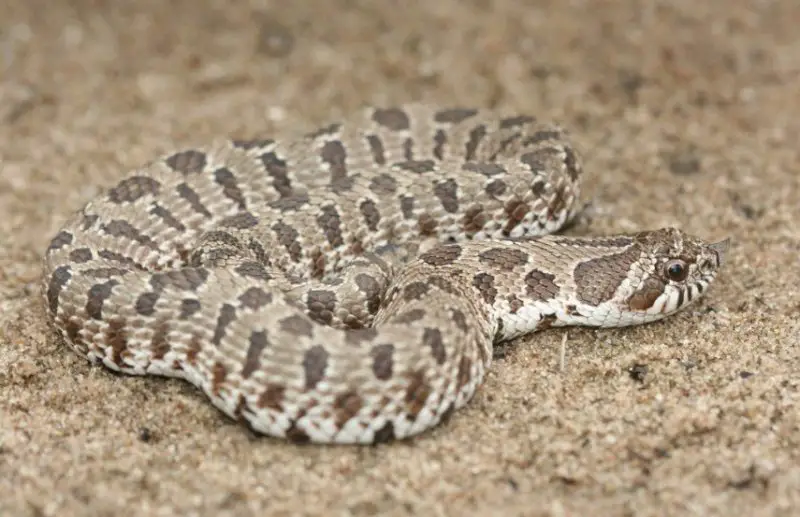
The Plains Hog-nosed Snake (Heterodon nasicus) has an adult length that varies from 15 to 39 inches. They have patches of different tones of brown, with larger longitudinal blotches on the neck, alternating rows of tiny dark spots along the sides, and darker blotches on the back. Additionally, their rostral (nose) scale is larger.
These snakes are good burrowers, using the tunnels of deceased animals for protection from the heat and hibernation. They like open, sandy, or gravelly settings.
Impressive defense displays are a well-known characteristic of Plains Hog-nosed Snakes. When they are first threatened, they could try to bury themselves, hide in a burrow, or just stay still and cover their heads with their coils. They will puff up their bodies, hiss loudly, spread their jaws and necks like cobras, and perform false strikes with their mouths closed if they are bothered any more.
Should these strategies not work, they will roll onto their backs and pretend to be dead, going limp and opening their mouths. They might even bleed from the mouth and cloaca, release odor and feces, and regurgitate food. Unfortunately, people who are afraid of them have occasionally murdered them as a result of their dramatic performances.
North American Racer
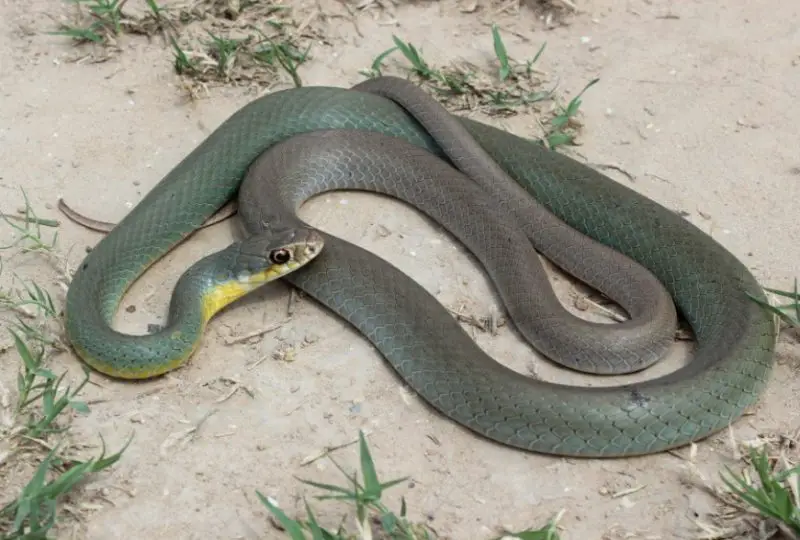
The normal length of an adult North American Racer (Coluber constrictor) is between 50 and 152 cm (20 and 60 in). Subspecies differ in the patterns and textures of their skin, although most have a lighter underbelly and a solid coloration. As their name suggests, they are some of Montana’s swiftest snakes, at velocities of up to 3.5 mph (5.6 kph). These lively snakes are known to lift their heads above the grass to observe their surroundings. They are also inquisitive and have good vision.
North American Racers do not crush their prey, despite their scientific name (constrictor). Instead, they suck smaller prey alive and immobilize it by holding it down with their bodies.
These non-venomous snakes can be violent, biting, thrashing, urinating, and producing an offensive-smelling musk when they feel threatened or imprisoned. They can also shake their tails on dry leaves to resemble rattlesnakes. North American Racers are still common in many places, although they are threatened by habitat loss brought on by urbanization and development. They are also easily killed by fear, even though they pose no threat if left alone.
Northern Rubber Boa
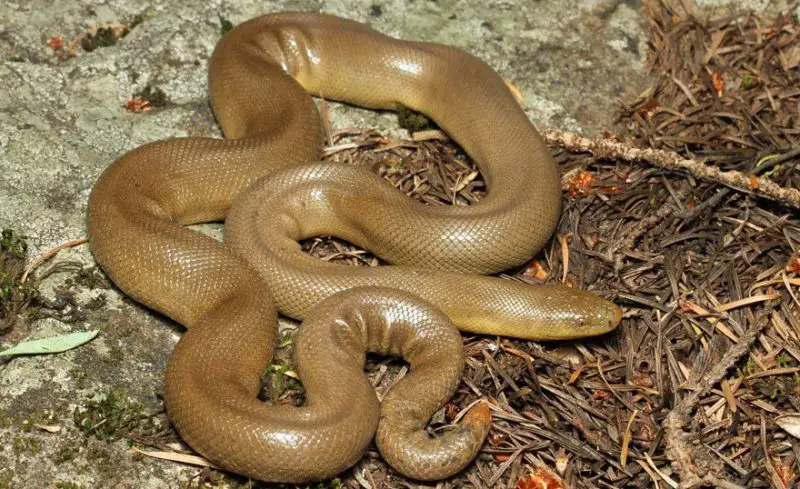
Adults of this species, which is often referred to as the Coastal Rubber Boa (Charina bottae), have a length range of 38 to 84 cm (1.25 to 2.76 feet). They have a lighter belly and smooth, glossy scales that range in hue from tan to dark brown. Rubber Boas are distinguished by their short, blunt tail, which is frequently confused with their head. They have a texture and appearance similar to rubber due to their loose, wrinkled skin.
In Montana, northern rubber boas can be found thriving in a variety of habitats, such as high alpine settings, chaparrals, meadows, deciduous and coniferous woods, and grasslands. Because they cannot withstand high temperatures, they are not found in hot, arid regions.
Typically, these snakes are located in hiding places like burrows, logs, rocks, and leaf litter. They are frequently used to assist people in overcoming their fear of snakes because of their benign nature. They hardly ever try to bite or strike, but if they smell danger, they can emit a potent odor from their vent.
Prairie Rattlesnake
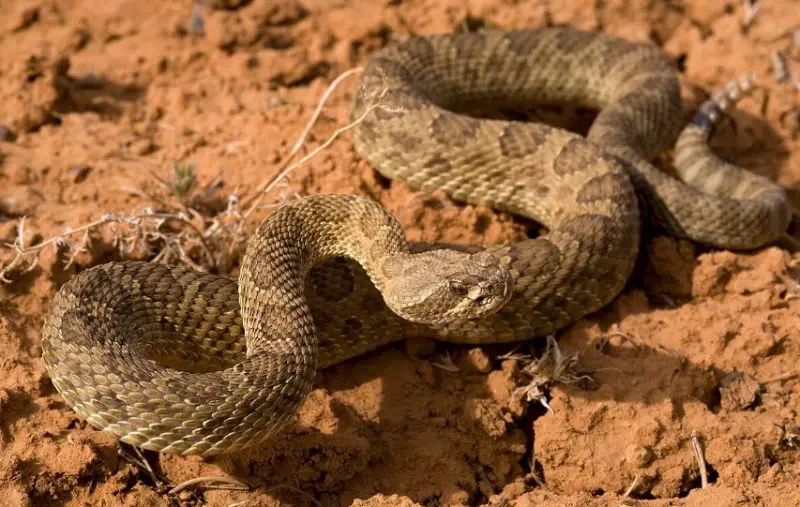
The color of prairie rattlesnakes (Crotalus viridis) varies remarkably, from greenish-gray to yellow, and they have dark spots that create rings close to their tails. Adults have a large triangular head, oval eyes, heat-sensing pits, and a rattling tail. They grow to be between 3.3 and 5 feet long.
These poisonous snakes live up to 9,500 feet above sea level in Montana’s grasslands, prairies, and semi-desert shrublands. They hibernate in group dens throughout the winter, going back to the same den annually. They may coil and rattle as a warning before striking, but when attacked, they either blend in or retreat stealthily. Despite being classified as a species of least concern, habitat loss and hunting are causing their populations to decline.
Red-sided Garter Snake
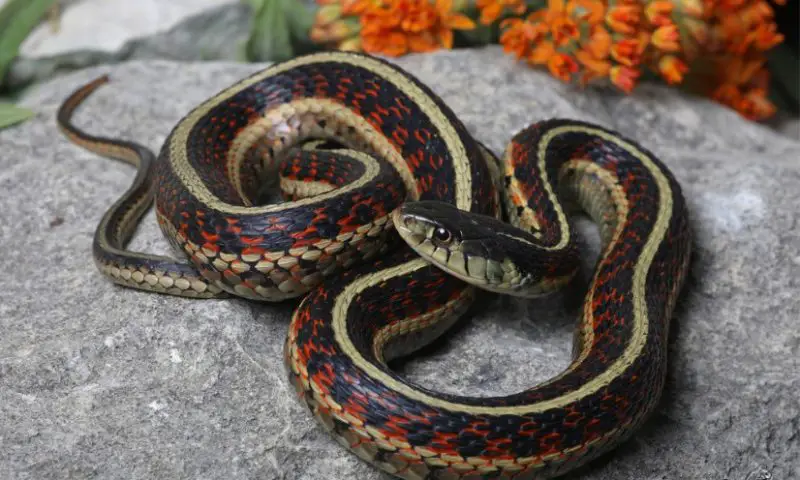
Though its color might vary, the Red-sided Garter Snake (Thamnophis sirtalis parietalis) is usually dark green to black in hue. It has three characteristic yellow stripes: one on each side and one going down its back. As suggested by its name, it has orange or red bars running between the yellow stripes along its sides. Being a habitat generalist, this subspecies of the common garter snake can be found in a range of settings in Montana, such as farms, marshes, woods, shrublands, and rocky places. Leeches, earthworms, and frogs are among their food sources.
In some regions, males can outnumber females after hibernation, leading to “mating frenzies” where many snakes gather. To endure the colder months, they hibernate below the frost line, often in dens housing hundreds or even thousands of individuals.
Terrestrial Garter Snake
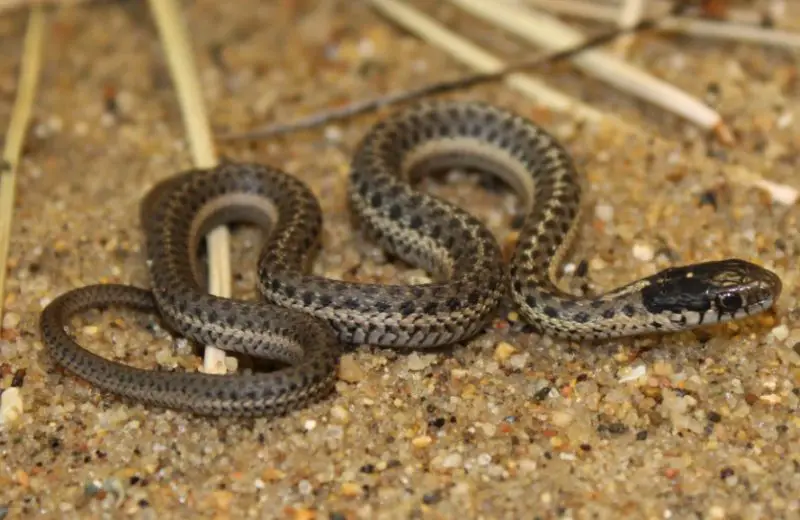
The size range of an adult Terrestrial Garter Snake (Thamnophis elegans) is 18 to 41 inches. The majority have two stripes on their sides and one down their back, with three stripes in yellow, bright orange, or white. Individuals can exhibit red and black dots, greenish or brownish tones, or occasionally entirely black forms because of their highly varied pigmentation. It might be difficult to identify this snake in Montana because of its diverse look and the disagreement among experts on its six subspecies.
This species can be found in a variety of environments, including woods, grasslands, and hilly regions up to 13,000 feet above sea level. They are mostly terrestrial, but they can swim very well. Unlike most garter snakes in Montana, which tend to just capture and swallow their prey, these snakes employ constriction to immobilize their victims. Their weak venom can cause pain and swelling in humans, but other than that, they are harmless and not aggressive.
Plains Garter Snake
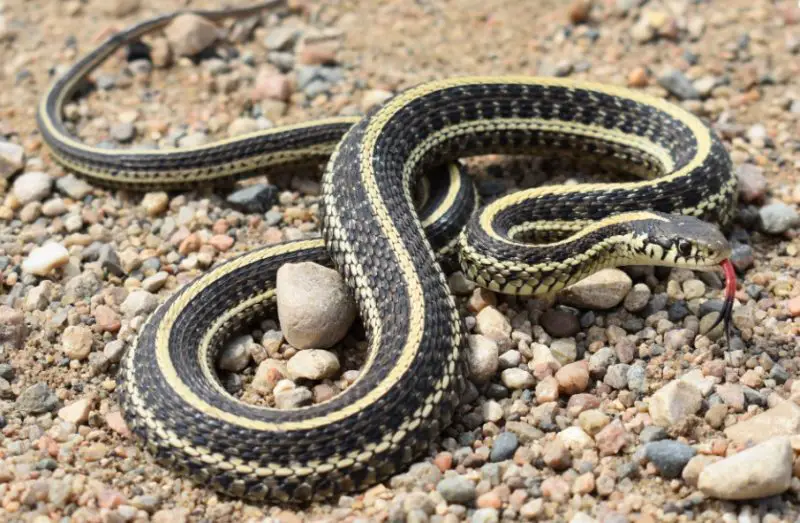
The typical length of an adult Plains Garter Snake (Thamnophis radix) is 36 inches. Their hue is gray-green, with greenish-yellow stripes down each side and a noticeable orange stripe down the back. On top of the skull, there are noticeable pale yellow patches.
Plains garter snakes are typically found in meadows and prairies close to freshwater sources in Montana. They live in landscapes that have been altered by humans and are often found next to vacant lots, rubbish piles, and abandoned structures. Among all snake species, this one can withstand extremely frigid temperatures; on warmer winter days, it occasionally emerges from hibernation.
They mostly consume earthworms, slugs, and tiny amphibians, although they have also been observed scavenging small animals and birds, including bank swallows and eastern meadowlarks.

